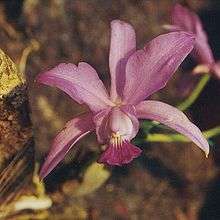Cattleya walkeriana
Cattleya walkeriana (Walker's cattleya) is a species of orchid. It differs from most species of Cattleya by having inflorescences which arise from the rhizome instead of from the apex of the pseudobulb[nb 1]. In its native habitat (Brazilian Central Plateau) it grows as either an epiphyte or a lithophyte, sometimes in full sun[1][nb 2]. Pseudobulbs are relatively short, bulbous or fusiform, with one or two ovate leaves at the apex. Inflorescence is one- or few-flowered, about 8" (20 cm) tall. Flowers are 4-5" (9-12 cm) across.[2][3]
| Cattleya walkeriana | |
|---|---|
 | |
| Scientific classification | |
| Kingdom: | |
| (unranked): | |
| (unranked): | |
| Order: | |
| Family: | |
| Subfamily: | |
| Tribe: | |
| Subtribe: | |
| Genus: | |
| Subgenus: | C. subg. Rhizantha |
| Species: | C. walkeriana |
| Binomial name | |
| Cattleya walkeriana Gardner | |
| Synonyms | |
| |
Genetically C. walkeriana is close to bifoliate Cattleyas.[4] The diploid chromosome number of C. walkeriana has been twice determined as 2n = 40; the diploid chromosome number of the variety C. walkeriana var. princeps L.C.Menzes has been determined as 2n = 80.[5]
Notes
- The only other Cattleya species that exhibits this trait is C. nobilior.
- In culture some protection from direct sun is needed, as plants not habituated to full sun will readily sunburn.
External links
- "Brazilian Orchids - Orchid News 33". www.delfinadearaujo.com.
- "IOSPE PHOTOS". www.orchidspecies.com.
- I. F. La Croix. The New Encyclopedia of Orchids: 1500 Species in Cultivation (Timber Press, 2008), p.92
- Van den Berg, Cassio. "Reaching a compromise between conflicting nuclear and plastid phylogenetic trees: a new classification for the genus Cattleya (Epidendreae; Epidendroideae; Orchidaceae)." Phytotaxa 186.2 (2014): 75-86.
- page 251 of L. P. Felix and M. Guerra: "Variation in chromosome number and the basic number of subfamily Epidendroideae (Orchidaceae)" Botanical Journal of the Linnean Society 163(2010)234—278. The Linnean Society of London. Downloaded October 2010 from onlinelibrary.wiley.com